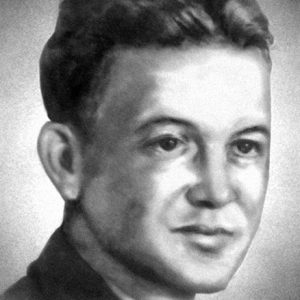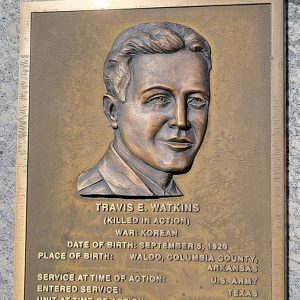calsfoundation@cals.org
Travis Earl Watkins (1920–1950)
Travis Earl Watkins was an Arkansas native who served in the U.S. Army during World War II and the Korean War. He received a posthumous Medal of Honor for gallantry during a four-day engagement with North Korean soldiers.
Travis E. Watkins was born on September 5, 1920, in Waldo (Columbia County) to salesman Joe E. Watkins and Angie Watkins. By 1930, the couple had divorced, and his mother had returned to her native Texas, living at Winters in Runnels County with her sons Travis (age nine), Tris (eight), and Truman (five). The family later moved to Troup, Texas, and in 1939, Watkins joined the army.
He served in the Pacific during World War II, earning a Bronze Star during the Guadalcanal Campaign. He remained in the army after the war and married Madie Sue Barnett on April 15, 1948. The couple had two daughters.
When the Korean War broke out, Master Sergeant Watkins shipped out with Company H, Ninth Infantry Regiment, Second Infantry Division. On August 31, 1950, Watkins was among thirty U.S. soldiers who were cut off when North Korean troops broke through American lines near Yongsan. Watkins immediately took command of the detachment, set up a perimeter defense, and “directed action which repelled continuous, fanatical enemy attacks.” Watkins moved among his men’s positions, giving them advice and encouragement. When the beleaguered unit was running dangerously low on ammunition and grenades, Watkins shot and killed two enemy soldiers fifty yards outside the perimeter lines. He ran to their bodies to seize their weapons and ammunition but was attacked by three other North Koreans. Though wounded, he killed all three of them and returned to his position carrying the gear of all five enemy soldiers.
As the siege of the American position continued, six enemy soldiers established a sheltered position from which they could hurl grenades at the U.S. troops. Ignoring his wounds, Watkins moved to attack them with rifle fire, and, though immediately struck by machine gun fire, he killed all six of them before collapsing, paralyzed from the waist down. Watkins refused to eat, leaving the food for his comrades, and when it became apparent that they could no longer hold the position he ordered his surviving men to break through to U.S. lines. Watkins refused to let them bring him with them, fearing he would be a burden. He apparently died on September 3, 1950, after his men escaped.
Watkins was awarded the Medal of Honor on February 16, 1951, and the citation stated that “through his aggressive leadership and intrepid action, this small force destroyed nearly 500 of the enemy before abandoning their position.”
In addition to the Medal of Honor, Watkins received a Bronze Star, Purple Heart, Combat Infantryman’s Badge, Korean Service Medal, United Nations Service Medal, National Defense Service Medal, Korean Presidential Unit Citation, and Republic of Korea Service Medal. A housing unit at Fort Sam Houston, Texas, was named in his honor in 1961, and the naval supply vessel USNS Watkins was christened in his honor on July 28, 2000. The section of U.S. Highway 80 between Gladewater and Big Sandy, Texas, was designated the Travis E. Watkins Memorial Highway in 2012. Watkins is buried at Gladewater Cemetery in Gladewater.
For additional information:
Committee on Labor and Public Welfare, United States Senate. Medal of Honor 1863–1968. Washington DC: U.S. Government Printing Office, 1968.
Evans, Glenn. “Perry Signs Historic US 80 Bill.” Longview News-Journal, June 23, 2017.
Koonce, Sherry. “Bill to Honor Gladewater Veteran.” Longview News-Journal, November 12, 2012.
“Travis E. Watkins.” Texas State Cemetery. http://www.cemetery.state.tx.us/pub/user_form.asp?pers_id=11205 (accessed November 14, 2017).
Mark K. Christ
Little Rock, Arkansas
 Military
Military World War II through the Faubus Era, 1941 through 1967
World War II through the Faubus Era, 1941 through 1967 Travis Watkins
Travis Watkins  Travis Watkins Plaque
Travis Watkins Plaque 



Comments
No comments on this entry yet.